An Examination of the Thermal Comfort Impacts of Ficus altssima on the Climate in Lower Subtropical China during the Winter Season
Abstract
1. Introduction
- (1)
- Exploring the specific role and performance of F. altissima in various microclimatic indicators;
- (2)
- Revealing the distribution pattern of thermal comfort in the shade of F. altissima trees;
- (3)
- Comparing transpiration in different orientations of the tree canopy and differences in thermal comfort response;
- (4)
- Investigating the effects of various indicators on the PET and explaining the changes in the PET in combination with physical, physiological, and climatic parameters.
2. Material and Methods
2.1. Study Objects
2.2. Study Area and Time
2.3. Measurement Items
2.4. Calculation Method
3. Results
3.1. Microclimate Indicators Analysis
3.2. Transpiration
3.3. Physiological Equivalent Temperature
4. Discussion
4.1. Microclimate Parameters and PET
4.2. Transpiration and PET
4.3. Integrative Parameters and PET
5. Conclusions
- (1)
- Under winter conditions in the southern subtropics, the F. altissima canopy may both warm and cool the environment, and may both reduce solar radiation in the shade and increase local solar radiation. These manifestations were related to the corresponding LAI under physiological indicators as well as being a two-way consequence of the hot spot effect.
- (2)
- A dense tree canopy is more conducive to maintaining a stable temperature and humidity in the shade and also allows for a more uniform wind distribution across the canopy. Unfortunately, the attenuation of wind by single trees was very weak, and no significant wind resistance was observed in this project.
- (3)
- Shade can influence human comfort by keeping people in relative thermal comfort for most of the daytime sunny weather in winter. Changes in the thermal comfort index PET could be explained by microclimate variables, transpiration, and so forth. Among them, solar radiation and air temperature were the climatic factors with the highest degree of explanation for the PET. While the transpiration of the entire plant could not be used to measure comfort, the transpiration and cooling effect on the east side could reasonably explain the PET in the shade of the forest.
- (4)
- By combining and refining physical, physiological, and climatic indicators and using multiple regression analysis, three models were developed that could explain the development of the PET. The first one combined physical and physiological parameters and found that TH and GC could partially explain the degree of thermal comfort. The second one combined physical, physiological, and climatic parameters and found that four indicators, Ta, V, Tmrt, and GC, could highly explain the thermal comfort changes. The third one used the comprehensive index Tmrt combined with wind speed and again confirmed that they are the controlling indexes affecting the direction of comfort.
Author Contributions
Funding
Institutional Review Board Statement
Informed Consent Statement
Data Availability Statement
Acknowledgments
Conflicts of Interest
References
- Crum, S.M.; Shiflett, S.A.; Jenerette, G.D. The influence of vegetation, mesoclimate and meteorology on urban atmospheric microclimates across a coastal to desert climate gradient. J. Environ. Manag. 2017, 200, 295–303. [Google Scholar] [CrossRef] [PubMed]
- Klemm, W.; Heusinkveld, B.G.; Lenzholzer, S.; Jacobs, M.H.; Van Hove, B. Psychological and physical impact of urban green spaces on outdoor thermal comfort during summertime in The Netherlands. Build. Environ. 2015, 83, 120–128. [Google Scholar] [CrossRef]
- Cohen, P.; Potchter, O.; Matzarakis, A. Daily and seasonal climatic conditions of green urban open spaces in the Mediterranean climate and their impact on human comfort. Build. Environ. 2012, 51, 285–295. [Google Scholar] [CrossRef]
- Kántor, N.; Kovács, A.; Takács, Á. Small-scale human-biometeorological impacts of shading by a large tree. Open Geosci. 2016, 8, 231–245. [Google Scholar] [CrossRef]
- Stocco, S.; Cantón, M.A.; Correa, E.N. Design of urban green square in dry areas: Thermal performance and comfort. Urban For. Urban Green. 2015, 14, 323–335. [Google Scholar] [CrossRef]
- Massetti, L.; Petralli, M.; Napoli, M.; Brandani, G.; Orlandini, S.; Pearlmutter, D. Effects of deciduous shade trees on surface temperature and pedestrian thermal stress during summer and autumn. Int. J. Biometeorol. 2019, 63, 467–479. [Google Scholar] [CrossRef]
- Coutts, A.M.; White, E.C.; Tapper, N.J.; Beringer, J.; Livesley, S.J. Temperature and human thermal comfort effects of street trees across three contrasting street canyon environments. Theor. Appl. Climatol. 2016, 124, 55–68. [Google Scholar] [CrossRef]
- Hsieh, C.-M.; Jan, F.-C.; Liman, Z. A simplified assessment of how tree allocation, wind environment, and shading affect human comfort. Urban For. Urban Green. 2016, 18, 126–137. [Google Scholar] [CrossRef]
- Sun, S.; Huang, K.; Hu, Y.; Xing, Z.; Su, Q. Analysis of Application of Environmental Engineering Construction in Ecological City. Smart Constr. Res. 2018, 2, 654. [Google Scholar] [CrossRef]
- De Abreu-Harbich, L.V.; Labaki, L.C.; Matzarakis, A. Effect of tree planting design and tree species on human thermal comfort in the tropics. Landsc. Urban Plan. 2015, 138, 99–109. [Google Scholar] [CrossRef]
- Li, K.; Liu, X.; Zhou, J. Impact of environmental characteristics in urban green spaces on outdoor thermal environment: A case study of Wuhan City, China. Indoor Built Environ. 2019, 28, 1217–1236. [Google Scholar] [CrossRef]
- Morakinyo, T.E.; Kong, L.; Lau, K.; Chao, Y.; Ng, E. A study on the impact of shadow-cast and tree-species on in-canyon and neighborhood’s thermal comfort. Build. Environ. 2017, 115, 1–17. [Google Scholar] [CrossRef]
- Miao, S.; Jiang, W.; Liang, P.; Liu, H.; Wang, X.; Tan, J.; Zhang, N.; Li, J.; Du, W.; Pei, L. Advances in Urban Meteorological Research in China. J. Meteorol. Res. 2020, 34, 218–242. [Google Scholar] [CrossRef]
- Chen, T.; Pan, H.; Lu, M.; Hang, J.; Lam, C.K.C.; Yuan, C.; Pearlmutter, D. Effects of tree plantings and aspect ratios on pedestrian visual and thermal comfort using scaled outdoor experiments. Sci. Total Environ. 2021, 801, 149527. [Google Scholar] [CrossRef]
- Fahmy, M.; Sharples, S.; Yahiya, M. LAI based trees selection for mid latitude urban developments: A microclimatic study in Cairo, Egypt. Build. Environ. 2010, 45, 345–357. [Google Scholar] [CrossRef]
- Li, Y.; Song, Y. Optimization of vegetation arrangement to improve microclimate and thermal comfort in an urban park. Int. Rev. Spat. Plan. Sustain. 2019, 7, 18–30. [Google Scholar] [CrossRef]
- Boukhabl, M.; Alkam, D. Impact of vegetation on thermal conditions outside, Thermal modeling of urban microclimate, Case study: The street of the republic, Biskra. Energy Procedia 2012, 18, 73–84. [Google Scholar] [CrossRef]
- Yang, Y.; Zhou, D.; Wang, Y.; Ma, D.; Chen, W.; Xu, D.; Zhu, Z. Economical and outdoor thermal comfort analysis of greening in multistory residential areas in Xi’an. Sustain. Cities Soc. 2019, 51, 101730. [Google Scholar] [CrossRef]
- Thom, J.K.; Coutts, A.M.; Broadbent, A.M.; Tapper, N.J. The influence of increasing tree cover on mean radiant temperature across a mixed development suburb in Adelaide, Australia. Urban For. Urban Green. 2016, 20, 233–242. [Google Scholar] [CrossRef]
- Lam, C.K.C.; Lee, H.; Yang, S.-R.; Park, S. A review on the significance and perspective of the numerical simulations of outdoor thermal environment. Sustain. Cities Soc. 2021, 71, 102971. [Google Scholar] [CrossRef]
- Mijorski, S.; Cammelli, S.; Green, J. A hybrid approach for the assessment of outdoor thermal comfort. J. Build. Eng. 2019, 22, 147–153. [Google Scholar] [CrossRef]
- Rahman, M.A.; Hartmann, C.; Moser-Reischl, A.; von Strachwitz, M.F.; Paeth, H.; Pretzsch, H.; Pauleit, S.; Rötzer, T. Tree cooling effects and human thermal comfort under contrasting species and sites. Agric. For. Meteorol. 2020, 287, 107947. [Google Scholar] [CrossRef]
- Shahidan, M.F.; Jones, P. Plant Canopy Planting Design in Modifying Urban Thermal Environment: Theory and Guidelines. In Proceedings of the PLEA 2008—25th Conference on Passive and Low Energy Architecture, Dublin, Ireland, 22–24 October 2008. [Google Scholar]
- Sabrin, S.; Karimi, M.; Nazari, R.; Pratt, J.; Bryk, J. Effects of Different Urban-Vegetation Morphology on the Canopy-level Thermal Comfort and the Cooling Benefits of Shade Trees: Case-study in Philadelphia. Sustain. Cities Soc. 2021, 66, 102684. [Google Scholar] [CrossRef]
- Feng, X.; Zhang, Y.; Xu, G.; Huang, C.; He, C. Energy Balance Observation and Sensible Heat Model Optimization for Urban Tree Canopy in the Hot-humid Region. Build. Sci. 2021, 37, 168–179. [Google Scholar]
- Liu, Z.; Zheng, S.; Zhao, L. Evaluation of the ENVI-Met vegetation model of four common tree species in a subtropical hot-humid area. Atmosphere 2018, 9, 198. [Google Scholar] [CrossRef]
- Takács, Á.; Kiss, M.; Hof, A.; Tanács, E.; Gulyás, Á.; Kántor, N. Microclimate Modification by Urban Shade Trees—An Integrated Approach to Aid Ecosystem Service Based Decision-making. Procedia Environ. Sci. 2016, 32, 97–109. [Google Scholar] [CrossRef]
- Liu, Z.; Brown, R.D.; Zheng, S.; Zhang, L.; Zhao, L. The effect of trees on human energy fluxes in a humid subtropical climate region. Int J. Biometeorol. 2020, 64, 1675–1686. [Google Scholar] [CrossRef]
- ISO-7726; Ergonomics of the Thermal Environment-Instruments for Measuring Physical Quantities. ISO: Geneva, Switzerland, 1998.
- Konarska, J.; Uddling, J.; Holmer, B.; Lutz, M.; Lindberg, F.; Pleijel, H.; Thorsson, S. Transpiration of urban trees and its cooling effect in a high latitude city. Int. J. Biometeorol. 2016, 60, 159–172. [Google Scholar] [CrossRef]
- Zhu, L.-W.; Ping, Z. Temporal variation in sap-flux-scaled transpiration and cooling effect of a subtropical Schima superba plantation in the urban area of Guangzhou. J. Integr. Agr. 2013, 12, 1350–1356. [Google Scholar] [CrossRef]
- Yang, S. A sttudy on the effect of decreasing temperature and increasing humidity of urban afforestation trees. Geogr. Res. 1994, 13, 74–80. [Google Scholar]
- Chen, X.; Zhao, P.; Hu, Y.; Ouyang, L.; Zhu, L.; Ni, G. Canopy transpiration and its cooling effect of three urban tree species in a subtropical city-Guangzhou, China. Urban For. Urban Green. 2019, 43, 126368. [Google Scholar] [CrossRef]
- Lee, R. Forest Microclimatology; Columbia University Press: New York, NY, USA, 1978. [Google Scholar]
- Matzarakis, A.; Mayer, H.; Iziomon, M. Applications of a universal thermal index: Physiological equivalent temperature. Int. J. Biometeorol. 1999, 43, 76–84. [Google Scholar] [CrossRef]
- Schulze, E.D.; Lange, O.L.; Kappen, L.; Evenari, M.; Buschbom, U. The role of air humidity and leaf temperature in controlling stomatal resistance of Prunus armeniaca L. under desert conditions. Oecologia 1975, 18, 219–233. [Google Scholar] [CrossRef]
- Kuusk, A. The hot spot effect in plant canopy reflectance. In Photon-Vegetation Interactions; Springer: Cham, Switzerland, 1991; Volume 139, p. 159. [Google Scholar]
- Zweifel, R.; Böhm, J.P.; Häsler, R. Midday stomatal closure in Norway spruce—Reactions in the upper and lower crown. Tree Physiol. 2002, 22, 1125–1136. [Google Scholar] [CrossRef]
- Lin, T.-P.; Matzarakis, A.; Hwang, R.-L. Shading effect on long-term outdoor thermal comfort. Build. Environ. 2010, 45, 213–221. [Google Scholar] [CrossRef]
- Yoshida, A.; Hisabayashi, T.; Kashihara, K.; Kinoshita, S.; Hashida, S. Evaluation of effect of tree canopy on thermal environment, thermal sensation, and mental state. Urban Clim. 2015, 14, 240–250. [Google Scholar] [CrossRef]

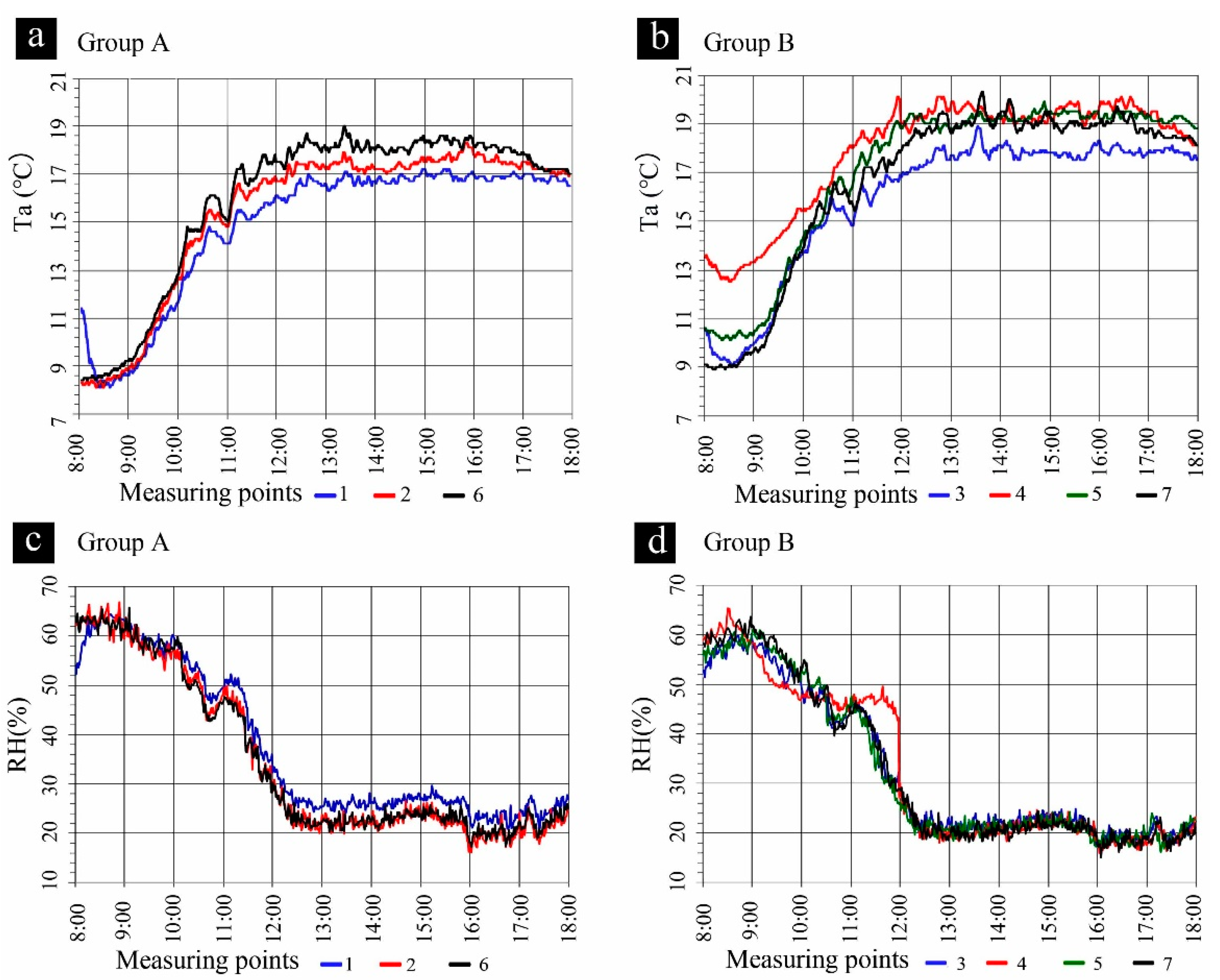

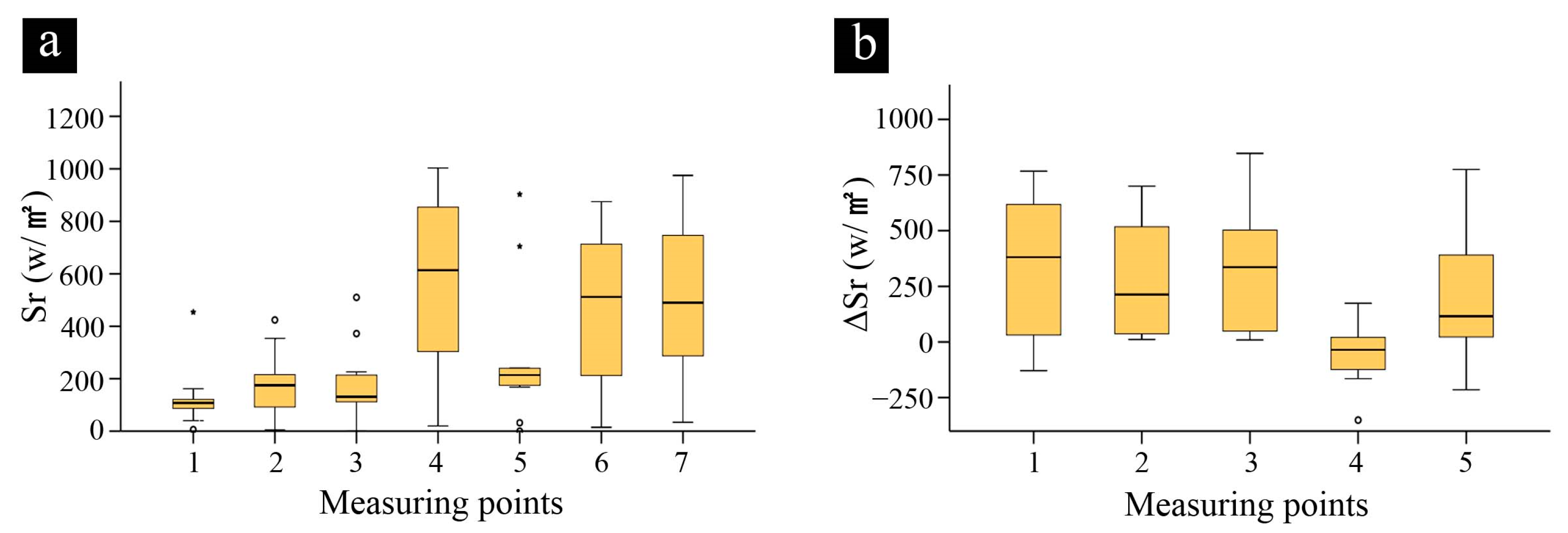
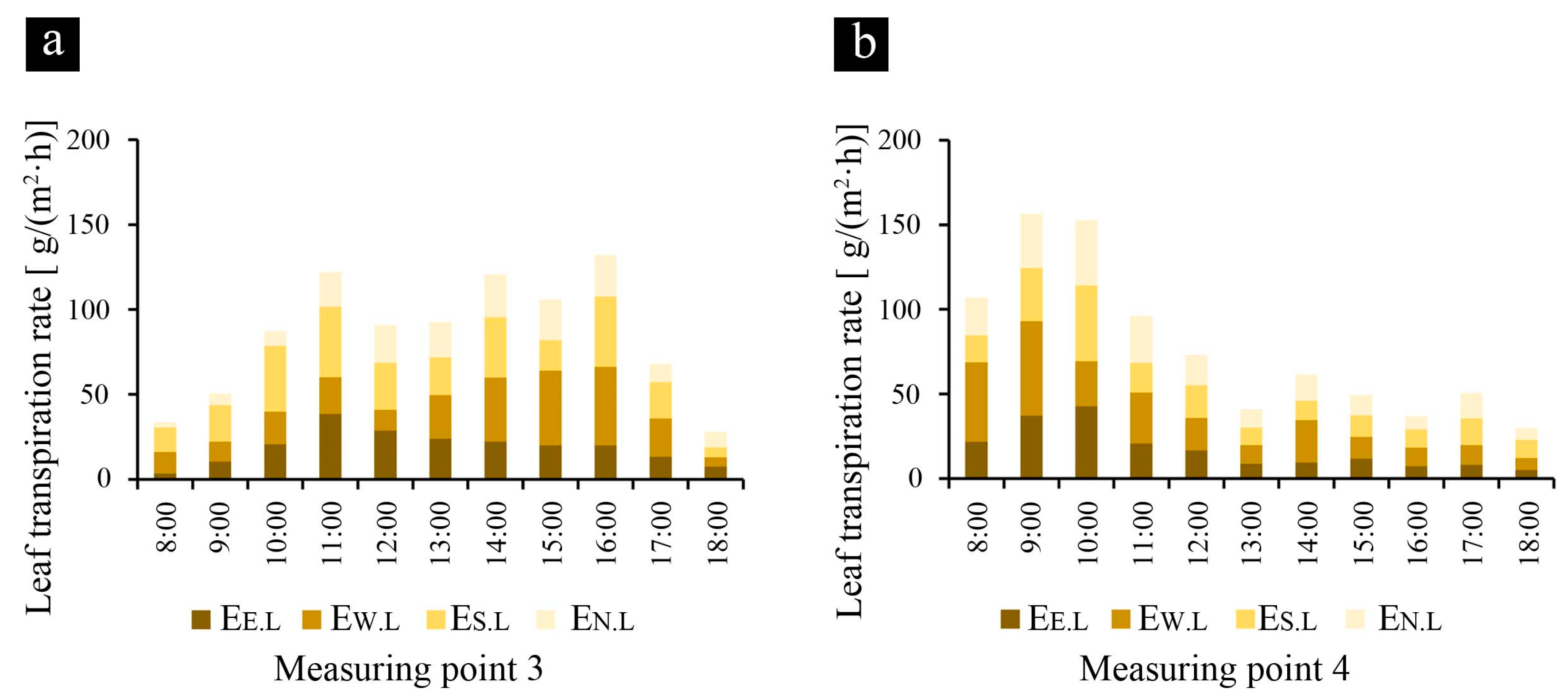

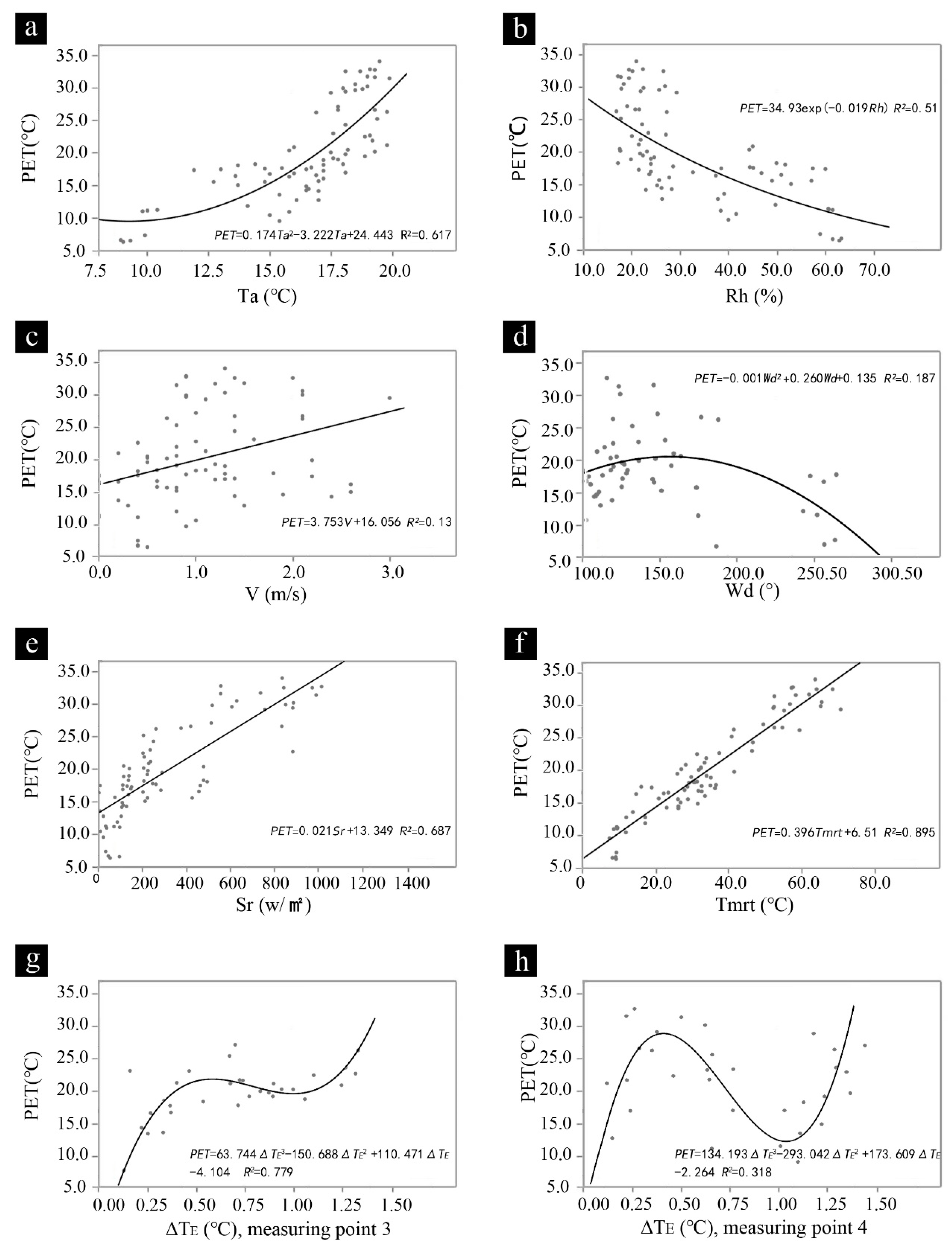
| Dates | Weather | Measurement Position | Measurement Items | Data Validity | Data Completeness | Whether to Use |
|---|---|---|---|---|---|---|
| 6 January 2021 | Cloudy, light rain | Measuring points 1–7 | Microclimate data | × | √ | × |
| 7 January 2021 | Medium rain | Measuring points 1–7 | Physiological data | × | × | × |
| 10 January 2021 | Cloudy | Measuring points 1–7 | Physical and physiological data | √ | √ | √ |
| 12 January 2021 | Sunny | Measuring points 1–7 | Physical and physiological data | √ | √ | √ |
| 13 January 2021 | Sunny | Measuring points 1–7 | Microclimate data | √ | √ | √ |
| 14 January 2021 | Sunny | Measuring points 3, 4 | Microclimate data and physiological data | √ | √ | √ |
| Type | Instrument Name, Model, Origin | Accuracy | Measurement Range | Characteristic Description | |
|---|---|---|---|---|---|
| Physical parameters |  | Laser rangefinder, Vertex Laser Geo, Sweden | ±0.1 m | 46 cm–700 m | High precision, fast response, measuring tree height, under branch height and crown width |
 | Tree girth ruler, C227, China | ±0.3 mm | 3 m (total length), 94 cm (diameter range) | Simple operation, used to measure 1.3 m high diameter at breast height | |
| Physiological parameters |  | Hemi digital plant canopy analysis system, Hemi View, UK | / | / | Fast calculation of sky geometry, leaf area index, etc., based on light and shadow components |
 | 1/10,000 balance scales, FA324C, China | ±0.1 mg | 0–320 g | Highly accurate weighing to help calculate transpiration rates | |
| Microclimatic parameter | 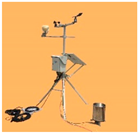 | Urban multi-factor climate data acquisition instrument, HQZDZ-7, China | ±0.1 °C (Ta) ±2% (RH) ±0.3 °C (Ts) ±0.1 m/s (V) ±2 w/m2 (Sr) | −40–70 °C (Ta) 0–100% (RH) −200–260 °C (Ts) 0–45 m/s (V) 300–3000 nm (Sr) | Integrating air temperature, relative humidity, soil temperature, wind speed, and solar radiation, it can automatically record data |
 | Globe thermometer, HQWBGT, China | ±0.5 °C | 0–120 °C | Acquisition of surface radiation and air temperature | |
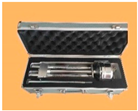 | Mechanical ventilation dry and wet table, HQDHM2, China | ±0.2 °C | −26–51 °C | Simple structure, measuring air temperature and humidity | |
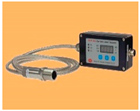 | Infrared high-precision thermometer, HQSI-111, China | ±0.2 °C | −10–65 °C | Portable, suitable for temperature measurement on various non-transparent surfaces | |
| PET (°C) | Thermal Perception | Grade of Physiological Stress |
|---|---|---|
| <4 | Very cold | Extreme cold stress |
| 4–8 | Cold | Strong cold stress |
| 8–13 | Cool | Moderate cold stress |
| 13–18 | Slightly cool | Slight cold stress |
| 18–23 | Comfortable | No thermal stress |
| 23–29 | Slightly warm | Slight heat stress |
| 29–35 | Warm | Moderate heat stress |
| 35–41 | Hot | Strong heat stress |
| >41 | Very hot | Extreme heat stress |
| Indicators | Minimum Statistic | Maximum Statistic | Mean Statistic | Mean Std. Error | Std. Deviation Statistic | Variance Statistic |
|---|---|---|---|---|---|---|
| QE | 37.0 | 399.1 | 177.19 | 23.10 | 108.33 | 11,736.42 |
| QW | 56.0 | 506.0 | 227.86 | 29.86 | 140.08 | 19,621.94 |
| QS | 61.2 | 428.7 | 218.70 | 25.59 | 120.02 | 14,405.33 |
| QN | 32.1 | 352.4 | 167.98 | 18.74 | 87.88 | 7723.55 |
| ∆TE | 0.1 | 1.3 | 0.60 | 0.08 | 0.36 | 0.13 |
| ∆TW | 0.2 | 1.7 | 0.76 | 0.10 | 0.47 | 0.22 |
| ∆TS | 0.2 | 1.4 | 0.73 | 0.09 | 0.40 | 0.16 |
| ∆TN | 0.1 | 1.2 | 0.56 | 0.06 | 0.29 | 0.09 |
Disclaimer/Publisher’s Note: The statements, opinions and data contained in all publications are solely those of the individual author(s) and contributor(s) and not of MDPI and/or the editor(s). MDPI and/or the editor(s) disclaim responsibility for any injury to people or property resulting from any ideas, methods, instructions or products referred to in the content. |
© 2023 by the authors. Licensee MDPI, Basel, Switzerland. This article is an open access article distributed under the terms and conditions of the Creative Commons Attribution (CC BY) license (https://creativecommons.org/licenses/by/4.0/).
Share and Cite
Deng, W.; Xia, C.; Chen, J.; Jiang, Y. An Examination of the Thermal Comfort Impacts of Ficus altssima on the Climate in Lower Subtropical China during the Winter Season. Sustainability 2023, 15, 2427. https://doi.org/10.3390/su15032427
Deng W, Xia C, Chen J, Jiang Y. An Examination of the Thermal Comfort Impacts of Ficus altssima on the Climate in Lower Subtropical China during the Winter Season. Sustainability. 2023; 15(3):2427. https://doi.org/10.3390/su15032427
Chicago/Turabian StyleDeng, Wan, Chunhua Xia, Jingyu Chen, and Yanji Jiang. 2023. "An Examination of the Thermal Comfort Impacts of Ficus altssima on the Climate in Lower Subtropical China during the Winter Season" Sustainability 15, no. 3: 2427. https://doi.org/10.3390/su15032427
APA StyleDeng, W., Xia, C., Chen, J., & Jiang, Y. (2023). An Examination of the Thermal Comfort Impacts of Ficus altssima on the Climate in Lower Subtropical China during the Winter Season. Sustainability, 15(3), 2427. https://doi.org/10.3390/su15032427





